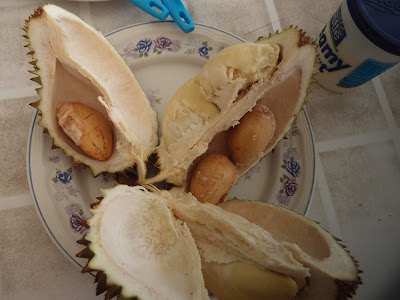The Philippines boasts myriad tantalizing tropical fruits. Some fruits grace North American and European grocery store shelves: yellow mango, banana (of all sizes), pineapple, papaya. Other fruits are harder to find outside of tropical countries, especially in their non-juice, non-dried form. Some examples include: mangosteen, breadfruit, lanzones, rambutan, jackfruit. Sadly (for tropical fruit gastronomes based in colder climes), the quality of such fruits diminishes rapidly with intercontinental travel, so a Philippine mango consumed in Canada is nowhere near as lami (Visayan word for delicious or sweet) as one consumed in the Philippines.
Of the more unusual fruit sold at local roadside fruit stands (and found in our fruit bowl), are two kinds that fall into the "stinky fruit" category: marang and durian.
Durian, in particular, emits an odour that is not merely mildly unpleasant, but (to many people) full on repulsive. For example, an ice cream parlour in Madison, Wisconsin once tried to create a durian-flavoured ice cream. Apparently, a neighbouring business, unfamiliar with the smell, called the fire department, complaining of a gas leak. After the arrival of fire trucks and a bomb squad, the parlour abandoned its recipe experimentation.
Personally, I consider other smells much more offensive (e.g. hockey gloves that have not been washed for several months or a car full of wet kayak gear in a July heat-wave). Frank disagrees. And so too, apparently, do many hotels and airlines, who single out durian and marang as banned substances.
 |
| Lobby display at the Marigold Hotel in CDO |
Here's an introduction to these two stinky fruits.
 |
| A pile of marang |
 |
| Young woman eating marang |
Durian (Durio spp.) is the king of stinky fruit. In the Philippines, it is grown almost exclusively in Mindanao. (There's debate over whether the fruit is native or was introduced.) It's pretty expensive as far as fruit goes. It retails for over 250P per kilo in the grocery store (inner fruit only). Buying whole fruits at the Cogon market or at a roadside kiosk is a more budget-friendly option (60-100P per kilo).
 |
| Durian vendor with her basket of fruit |
 The fruit has a hard green-brown exterior; its sharp spikes easily pierce through canvas grocery bags and the skin on your fingers. It's best to ask the fruit vendor to slice open the fruit before you buy. This reduces: 1) the chance of cutting your fingers and 2) the possibility of buying fruit with critters small enough to worm their way between the spikes and start devouring the soft flesh inside.
The fruit has a hard green-brown exterior; its sharp spikes easily pierce through canvas grocery bags and the skin on your fingers. It's best to ask the fruit vendor to slice open the fruit before you buy. This reduces: 1) the chance of cutting your fingers and 2) the possibility of buying fruit with critters small enough to worm their way between the spikes and start devouring the soft flesh inside.
There are several cultivars of durian. The one with white flesh has a lighter, more delicate taste. It's the preferred choice for those with a more sensitive nose. The yellow-fleshed durian has a bolder taste (and smell). The fruit itself is very creamy and rich; it melts in your mouth. It is very soft; its 'squishability' makes it an ideal baby food. (Mango and durian are tied atop Ada's list of favourite foods.)
 |
| A partially-eaten durian |
If you ever find yourself with the opportunity to indulge in such delicacies, I highly recommend it ... even if you have to hold your nose the entire time.
Nice article. :-)
ReplyDelete